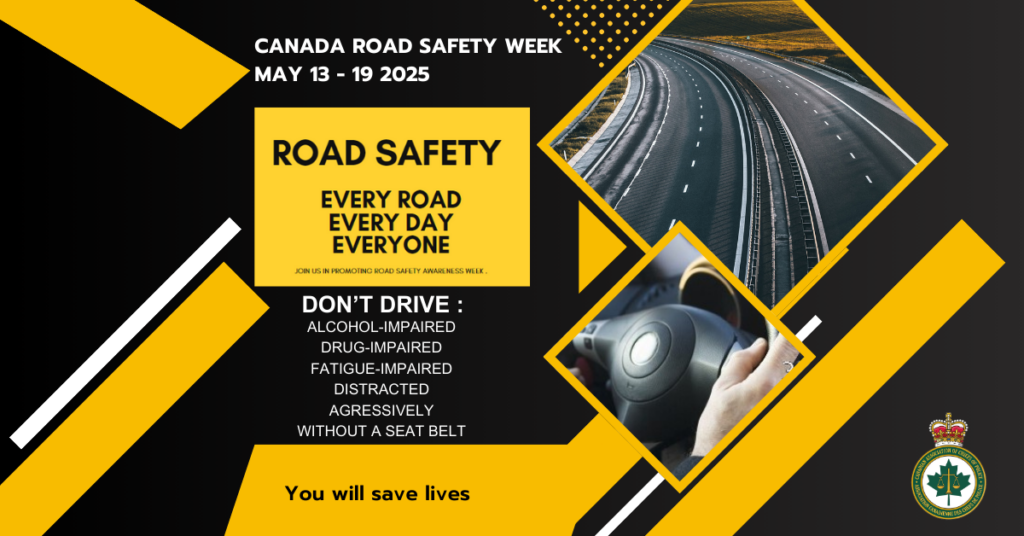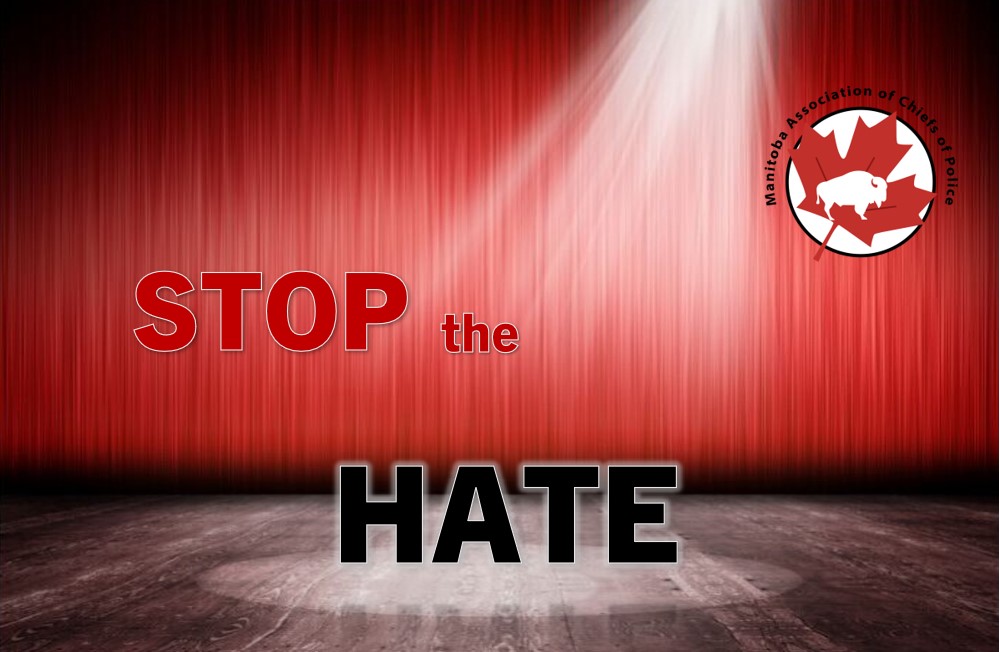
The theme for the 2025 campaign is “Every Road. Every Day. Everyone.“. We want to remind Canadians that they are in control of their driving on Canada’s roads and that they should be adopting safe driving behaviours to keep themselves, their passengers, other drivers, cyclists, and pedestrians safe.
Canada Road Safety Week is an enforcement-driven initiative led by the Canadian Association of Chiefs of Police (CACP), and more specifically by the CACP’s Traffic Safety Committee. It is designed to increase public compliance with safe driving measures in order to save lives and reduce injuries on Canadian roads.
This road safety awareness campaign is part of the broader Canada’s Road Safety Strategy 2025, which aims to make Canada’s roads the safest in the world. To this end, the campaign is focused on behaviours that put drivers, passengers, pedestrians and other vulnerable road users most at risk:
- drug-impaired driving
- alcohol-impaired driving
- fatigue-impaired driving
- distracted driving
- aggressive driving
- driving without a seatbelt
All enforcement agencies across the country are invited to actively participate in this campaign and to encourage citizens in their respective community to adopt safe driving practices.
#CRSW2025
#CRSW2025

About the Campaign
The “If You See Something, Say Something®” campaign was originally implemented and trademarked by the New York Metropolitan Transportation Authority (NY MTA) in 2002 and is licensed to the Canadian Association of Chiefs of Police (CACP) for the purpose of a national campaign in Canada.
The purpose of the “If You See Something, Say Something®” campaign is to raise awareness of suspicious activity that may constitute a national security threat and to emphasize the importance of reporting suspicious activity to law enforcement or security officials.
Threats to national security can come in many forms and early identification is possible. By working together, knowing what to look for and what to do with the information we receive, we can make a difference, ensuring safety and security for all of us.
The U.S. Department of Homeland Security (DHS) has designated September 25 as national “If You See Something, Say Something®” Awareness Day. For more information on the DHS campaign, visit https://www.dhs.gov/see-something-say-something.
Suspicious Activity
Identifying and reporting suspicious incidents help law enforcement and security agencies keep Canadians and Canada safe. It is important for frontline employees and the public to report anything they deem suspicious. Frontline employees are best placed to observe suspicious behaviours as they are familiar with their surroundings and know best what fits into their daily routine.
There are a number of indicators of terrorism and terrorism-related crime that Canadians can be on the look-out for:
Someone showing an unusual interest in or taking pictures/video of people, buildings, security features, or surrounding areas.
Someone trying to obtain or conduct training in security concepts.
Someone collecting materials such as cell phones, toxic substances, and weapons
Unauthorized people getting into a restricted area, system or protected site, or impersonating authorized personnel, which can include theft of uniforms or access badges
Damaging, manipulating, or breaking part of a facility, infrastructure, or sercured site
Interactions with, or challenges to personnel or systems that show physical, personnel or cyber security capabilities. This might look like suspicious items/packages, trying to get private information, and diversionary tactics.
Someone making or communicating a threat to harm or kill people or damage a facility, infrastructure, or secure site.
The presence of any single behaviour does not constitute a national security threat or other serious criminal activity. However, a cluster of behaviours may indicate suspicious activity worthy of in-depth examination. An occurrence may seem unimportant, but together, combined with other incident information, could be indicative of a greater threat. When an incident occurs or intelligence is received regarding a potential threat, early reporting to law enforcement is key to ensuring a timely response.
The “If You See Something, Say Something®” campaign respects the rights and privacy of citizens by emphasizing behaviour, rather than appearance, in identifying suspicious activity. Factors such as assumptions, race, ethnicity, national origin, gender or gender identity, sexual orientation, and/or religious affiliation are not suspicious. Partners should only report suspicious behaviours and situations, such as unattended bags, or packages or an individual breaking into a restricted area.
Reporting Suspicious Activity
If something seems wrong, notify law enforcement authorities as soon as possible. If you have any doubts or would like to report a suspicious incident, please contact your local police service or call the RCMP National Security Information Network at 1-800-420-5805.
Describe specifically what you observed, including: who or what you saw; when you saw it; where it occurred; and why it’s suspicious.
The reporting phone number must be monitored by an individual 24/7/365 to ensure any reported suspicious activity is handled immediately.
If there is an emergency, call 9-1-1.
SomethingIsWrong
Something is wrong is the latest Crime Stoppers province-wide campaign which focuses on meth dealers and traffickers in Manitoba. Through this initiative, police agencies are hoping to identify and stop methamphetamine dealers and traffickers.
“Law enforcement can not win this battle on their own,” said Paul Johnson, chair, Winnipeg Crime Stoppers.
“They need everyone’s help to provide the information they need to stop the flow of methamphetamine into our communities. Every piece of information — no matter how trivial — is important. The three Crime Stoppers programs are proud to be part of that community to create a ‘made-in-Manitoba solution’ to address this crisis.”
If you have information on a crime, call Winnipeg Crime Stoppers at 204-786-TIPS (204-786-8477). For residents living outside of the city of Winnipeg please call 1-800-222-8477. Callers never have to reveal their identity. If your tip is helpful, you are eligible to receive an award up to $2000 cash! All awards are paid out using a system designed to maintain your anonymity.
For more information visit the CrimeStoppers website at https://www.winnipegcrimestoppers.org/
Ransomware is a form of malware that encrypts a victim’s files. The attacker then demands a ransom from the victim to restore access to the data upon payment.
Users are shown instructions for how to pay a fee to get the decryption key. The costs can range from a few hundred dollars to thousands, payable to cybercriminals in Bitcoin.
Read more about how you can stop ransomware by clicking the image below.

Hate Crime vs. Hate Incident,
What’s the difference?
IMPORTANT: If you have been a victim of a HATE CRIME please report this to your local police department, or contact Crime Stoppers. Calls are always anonymous.
Winnipeg Crime Stoppers – 204-786-8477 (TIPS)
Manitoba Crime Stoppers – 1-800-222-8477 (TIPS)
Hate incidents often go unreported!
According to the Canadian Criminal Code, a HATE CRIME is defined as a crime motivated by hate, based on race, national or ethnic origin, language, colour, religion, sex, age, mental or physical disability, sexual orientation, or any other similar factor.
Only three sections of the Canadian criminal code specifically deal with hate crime: s. 318, s. 319. And s. 430. All hate crimes should be reported to the police.
A hate incident is a non-criminal action committed against a person or property, the motive for which is based in whole or in part upon the same characteristics mentioned above. Because they are non-criminal in nature, police are limited in their ability to be involved.

 Member Login
Member Login